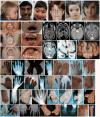Fifteen years of research on oral-facial-digital syndromes: from 1 to 16 causal genes
- PMID: 28289185
- PMCID: PMC5557276
- DOI: 10.1136/jmedgenet-2016-104436
Fifteen years of research on oral-facial-digital syndromes: from 1 to 16 causal genes
Abstract
Oral-facial-digital syndromes (OFDS) gather rare genetic disorders characterised by facial, oral and digital abnormalities associated with a wide range of additional features (polycystic kidney disease, cerebral malformations and several others) to delineate a growing list of OFDS subtypes. The most frequent, OFD type I, is caused by a heterozygous mutation in the OFD1 gene encoding a centrosomal protein. The wide clinical heterogeneity of OFDS suggests the involvement of other ciliary genes. For 15 years, we have aimed to identify the molecular bases of OFDS. This effort has been greatly helped by the recent development of whole-exome sequencing (WES). Here, we present all our published and unpublished results for WES in 24 cases with OFDS. We identified causal variants in five new genes (C2CD3, TMEM107, INTU, KIAA0753 and IFT57) and related the clinical spectrum of four genes in other ciliopathies (C5orf42, TMEM138, TMEM231 and WDPCP) to OFDS. Mutations were also detected in two genes previously implicated in OFDS. Functional studies revealed the involvement of centriole elongation, transition zone and intraflagellar transport defects in OFDS, thus characterising three ciliary protein modules: the complex KIAA0753-FOPNL-OFD1, a regulator of centriole elongation; the Meckel-Gruber syndrome module, a major component of the transition zone; and the CPLANE complex necessary for IFT-A assembly. OFDS now appear to be a distinct subgroup of ciliopathies with wide heterogeneity, which makes the initial classification obsolete. A clinical classification restricted to the three frequent/well-delineated subtypes could be proposed, and for patients who do not fit one of these three main subtypes, a further classification could be based on the genotype.
Keywords: ciliopathies; oral-facial-digital syndromes.
© Article author(s) (or their employer(s) unless otherwise stated in the text of the article) 2017. All rights reserved. No commercial use is permitted unless otherwise expressly granted.
Conflict of interest statement
Competing interests: None declared.
Figures




References
-
- Gurrieri F, Franco B, Toriello H, Neri G. Oral-facial-digital syndromes: review and diagnostic guidelines. Am J Med Genet A. 2007 Dec 15;143A(24):3314–23. - PubMed
-
- Toriello HV, Franco B, Bruel A-L, Thauvin-Robinet C. Oral-Facial-Digital Syndrome Type I. In: Pagon RA, Adam MP, Ardinger HH, Wallace SE, Amemiya A, Bean LJ, Bird TD, Fong CT, Mefford HC, Smith RJH, Stephens K, editors. GeneReviews(®) [Internet] Seattle (WA): University of Washington, Seattle; 1993. [cited 2016 Aug 23]. Available from: http://www.ncbi.nlm.nih.gov/books/NBK1188/ - PubMed
-
- Chung WY, Chung LP. A case of oral-facial-digital syndrome with overlapping manifestations of type V and type VI: a possible new OFD syndrome. Pediatr Radiol. 1999 Apr;29(4):268–71. - PubMed
-
- Erickson RP, Bodensteiner JB. Oro-facial-digital syndrome IX with severe microcephaly: a new variant in a genetically isolated population. Am J Med Genet A. 2007 Dec 15;143A(24):3309–13. - PubMed
Publication types
MeSH terms
Substances
Supplementary concepts
Grants and funding
- UC2 HL103010/HL/NHLBI NIH HHS/United States
- RC2 HL102926/HL/NHLBI NIH HHS/United States
- R01 HD085901/HD/NICHD NIH HHS/United States
- RC2 HL102924/HL/NHLBI NIH HHS/United States
- MR/K011154/1/MRC_/Medical Research Council/United Kingdom
- MR/M000532/1/MRC_/Medical Research Council/United Kingdom
- RC2 HL103010/HL/NHLBI NIH HHS/United States
- R01 GM060992/GM/NIGMS NIH HHS/United States
- R01 GM089933/GM/NIGMS NIH HHS/United States
- RC2 HL102923/HL/NHLBI NIH HHS/United States
- UC2 HL102926/HL/NHLBI NIH HHS/United States
- UC2 HL102923/HL/NHLBI NIH HHS/United States
- UC2 HL102924/HL/NHLBI NIH HHS/United States
- RC2 HL102925/HL/NHLBI NIH HHS/United States
- UC2 HL102925/HL/NHLBI NIH HHS/United States
LinkOut - more resources
Full Text Sources
Other Literature Sources
Molecular Biology Databases
